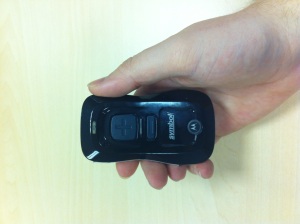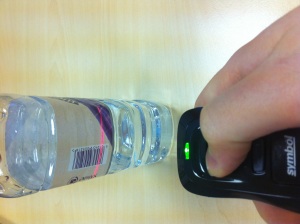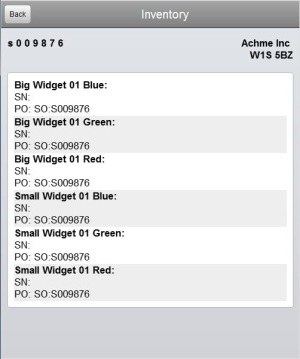Bluetooth Barcode Scanners For Mobile Android Devices: A New Approach for Asset Management
 Anyone who has spent time in a warehouse, stock room or even a superstore will likely be familiar with barcode scanning guns--the kind used for taking inventory, replenishment, auditing stock, price checking, and essentially any general asset management task. These barcode scanners are standard tools for most industries, usually used in tandem with some form of ruggedized device to record the scanned data. However, not only are some of these devices antiquated and therefore quite cumbersome, they can also be rather expensive for the limited functionality that they provide.
Anyone who has spent time in a warehouse, stock room or even a superstore will likely be familiar with barcode scanning guns--the kind used for taking inventory, replenishment, auditing stock, price checking, and essentially any general asset management task. These barcode scanners are standard tools for most industries, usually used in tandem with some form of ruggedized device to record the scanned data. However, not only are some of these devices antiquated and therefore quite cumbersome, they can also be rather expensive for the limited functionality that they provide.
CommonTime's Enterprise Mobility Solutions has recently undertaken a project to help a customer develop a more sophisticated and portable approach utilizing Android mobile devices and Bluetooth portable barcode scanners. These devices are more portable, easier to use, and significantly less expensive to implement than traditional barcode scanners.
These miniature Bluetooth scanners send all of the scanned information to an application designed  using CommonTime’s mDesign Studio, a suite that is used to develop applications which run across all mobile platforms (iOS, Android, Windows, etc.). In this particular instance the customer’s preference was Android, since that is what their infrastructure was already based upon.
using CommonTime’s mDesign Studio, a suite that is used to develop applications which run across all mobile platforms (iOS, Android, Windows, etc.). In this particular instance the customer’s preference was Android, since that is what their infrastructure was already based upon.
The mobile application is used in conjunction with the Android mobile device and the Bluetooth scanner for Asset Management purposes, such as taking inventory of the items or tracking goods in and out. Together, the Android mobile device, the mobile application, and the Bluetooth scanner become a very useful piece of equipment. For example, the application can display real-time analysis of a process in different formats, such as a table of results or a graph, which can be accessed by tilting the device to change the format of display.
 The inexpensive and compact Bluetooth barcode scanner can be used in the same way as a traditional scanner gun, but offers many advantages. The Bluetooth scanner is smaller and less cumbersome, and can even be used to read barcodes while the Android device is simply kept in the employee's pocket. Since the Android device and Bluetooth scanner are easier to carry and faster to use, the asset management process becomes more efficient and productivity increases.
The inexpensive and compact Bluetooth barcode scanner can be used in the same way as a traditional scanner gun, but offers many advantages. The Bluetooth scanner is smaller and less cumbersome, and can even be used to read barcodes while the Android device is simply kept in the employee's pocket. Since the Android device and Bluetooth scanner are easier to carry and faster to use, the asset management process becomes more efficient and productivity increases.
Enterprise Mobility has previously attempted to utilize the built-in cameras of mobile phones to solve these issues; however, the placement, capabilities, and speed of the cameras have proved problematic. A separate device like a Bluetooth portable scanner specifically designed for barcode scanning and asset management is a better solution and provides more accurate results.
Because the scanners are wirelessly connected to fully functioning Android devices, the asset management application does not need to be the only function of the Android device. The mobile Android device can also run other applications for different processes; for example, sales applications or HR applications for vacation time, etc. This means that the employee can perform multiple mobile processes from the single device.
The organization benefits from this setup since they are not tied to any particular infrastructure. For  example, the current phenomenon of BYOD (Bring Your Own Device) means that organizations may allow individual employees to provide their own personal device of preference to perform their duties. Therefore, the ability to deploy and manage these solutions across multiple platforms is paramount in the minds of process developers. This also allows organizations to be flexible in their mobility strategy. While the organization may use iOS devices currently, they may wish to change to Android later, and with this approach the applications would not need to be redesigned.
example, the current phenomenon of BYOD (Bring Your Own Device) means that organizations may allow individual employees to provide their own personal device of preference to perform their duties. Therefore, the ability to deploy and manage these solutions across multiple platforms is paramount in the minds of process developers. This also allows organizations to be flexible in their mobility strategy. While the organization may use iOS devices currently, they may wish to change to Android later, and with this approach the applications would not need to be redesigned.
Overall, this project illustrates how mobile technology can provide new, novel approaches, even to existing mobile processes. It is also opening up the technology to new markets and smaller organizations that previously may not have had the budget for an asset management system.
For More information on CommonTime’s Enterprise Mobility Solutions please visit: www.CommonTime.com
Alternatively please email:
About the Author
James Tomkinson is a Postgraduate Educated Marketer who has worked for large, Intercontinental Companies involved in varying industries, from Banking to Nuclear Engineering. He is now responsible for the Digital Marketing at CommonTime a leading Enterprise Application developer and is tasked with developing its digital brand through multiple channels.Outside of work James is a keen musician of multiple instruments and is a qualified Tennis coach who can often be found on the Tennis Court somewhere around Derbyshire England.
Related articles:
Bring Your Own Mobile Devices (BYOD) for Employee Convenience, Corporate Cost Savings
Bluetooth Barcode Scanners for iPad
{jcomments on}
